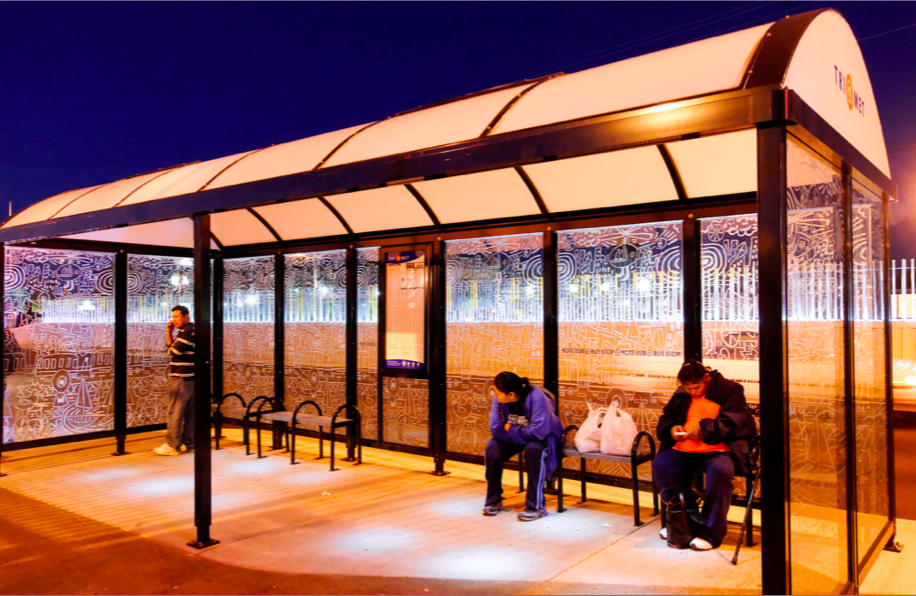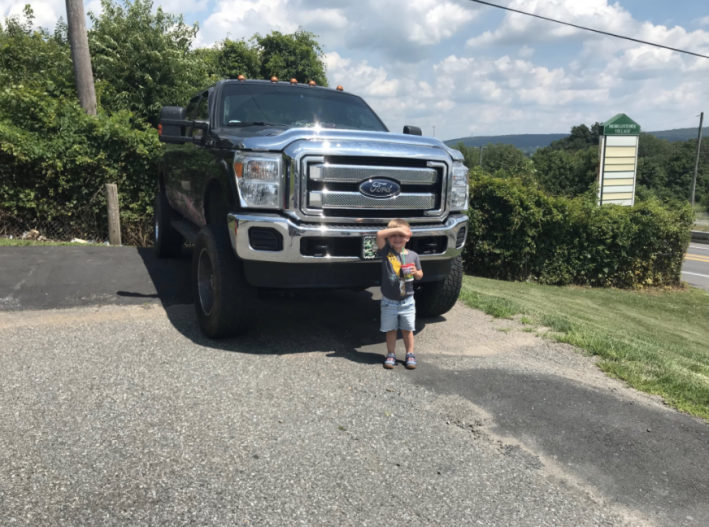How Our Transport System is Biased Against Women
11:34 AM EDT on August 29, 2019

Photo: TransitCenter
In her book Invisible Women, published earlier this year, Caroline Craido Perez uncovers the way designing essentially everything with the default user being an averaged size man puts women at risk.
One of her most striking examples was crash test dummies. Women are safer drivers on average than men. Yet Perez points out they are 17 percent more likely to be killed in a crash because cars have been designed around the bodies of male crash test dummies. U.S. safety regulators did not start using "female" crash test dummies until 2011.
It's just one example of many that the world we live in is designed by men — for men.
But there are so many examples of how gender bias plays out in transportation and city building, so we've compiled a handy list. (Caveat: Some of the items below apply to any parent or child caregiver, but we included them because childcare still falls primarily on women in the U.S.)
Car seats
In the United States, we put the onus for traffic safety almost entirely on parents. It can be a real burden, and in the U.S. that burden falls primarily on mothers. For example, in many places children can't play outside unsupervised without fear of being hit by a car driver.
One way we externalize safety for children and make it the parents' responsibility is with car seats. Parents/caregivers must buy and install them. This is harder than it sounds, and most people do it wrong.
Cars should come equipped with seats that can accommodate children of all ages, says Neil Arason, a Canadian traffic safety expert and author of No Accident. He calls designing car seats to be safe for adults only a "bizarre anachronism," noting "integrated child seats have been around for 20 years."
Because they do not come standard in cars, parents must lug around car seats if they have to switch cars, for example, or fly somewhere on vacation. To top it off, we sometimes criminalize parents if they get it wrong (this is just one area where racism overlaps with sexism and women of color can face particular hazards).
Taxis don't accommodate small kids
This second complaint ties in with the first one. Taxis as well as Uber and Lyft make basically no attempt to accommodate people traveling with small children safely. In some states, parents can only make a limited number of trips by taxi without a car seat.
Outside of major cities, or premium services, Uber and Lyft just don't offer car seats. This is increasingly problematic as cities and transit agencies increasingly incorporate these services into core transit systems. Still, there is no sustained push for them to change anything to accommodate young children.
Buses don't accommodate strollers
So women — or men if they are doing the (young) child schlepping — can't take Uber safely, by and large. They also face barriers to riding the bus. Namely, many agencies require them to break down strollers and stow them, though there might not be anywhere to do that.
One new mother in D.C. told the Washington Post that she stood outside a Metrobus and cried after being denied access without folding her stroller with her 3-month-old following a difficult phase where she had basically been housebound with the infant. Some of the more progressive agencies such as Chicago's CTA and Seattle's King County Metro have revised these policies to allow open strollers (provided they do not interfere with accessibility for people with disabilities).
European buses have spaces automatically to accommodate something as common and practical for bus riders as a stroller with special areas near the front.
Transit agencies are blasé about sexual harassment
Sexual harassment on transit is a huge problem for women. A 2019 study by USC professors found women were half as likely to take advantage of a new light rail line near their house in large part because of concerns about safety.
But a survey by UCLA researchers found just three of 110 transit agencies interviewed in 2006 were doing anything formal to specifically protect women from harassment and assault.
Hyper-macho dangerous trucks
Young men cause a hugely disproportionate share of traffic fatalities; the combination of testosterone, youth and big motors can be deadly. Young men are involved in fatal crashes at 2.2 times the rate of young women — even though both are at elevated risk compared to older drivers. Young men do pay much higher insurance premiums to reflect this. On the other hand, in our culture, we've done little to rein in some of the more dangerous aspects of macho road culture. Instead, it is mostly celebrated in the media in games, songs and, of course, movie franchises like Fast and Furious.
Lifted pickup trucks with bull bars are a good example. These dangerous modifications in many states go completely unregulated. Meanwhile, Europe has banned bull bars, citing compelling evidence they kill people, especially children. The notion that other people's safety can be subordinated to the mostly male obsession with big cars reflects, in part, the privileged position men hold socially and politically.
Lack of protected bike infrastructure
The bike world has long bemoaned the "gender gap" in American cycling. Only about a quarter of U.S. cycling trips are made by women.
There's probably a whole host of social reasons for this, including "bro culture" at bike shops, fashion norms that discriminate against women and, obviously, the way women are treated on the roads.
But the main issue is safety — women say that feeling unsafe keeps them from biking at the same rate as men.
High-quality bike infrastructure helps close the gender gap. In Scandinavian cities known for their bikeways, like Copenhagen, the gender gap has been completely eliminated.
But in the United States, macho critiques of bike infrastructure, from prominent engineers who called themselves vehicular cyclists, held back the production of protected bike lanes known to produce more gender parity.
Too much focus on commuting
Transportation engineers — who by the way are overwhelmingly men — have long held up work commuting as the standard by which to base planning decisions.
But women make many more trips than men daily, and they commute shorter distances on average. According to the American Enterprise Institute, they spend 31 percent less time commuting in the U.S. then men. In addition, they are often responsible for more caregiving and retail trips.
U.S. transport planning has for ages privileged long trips over short. Big highway expansion projects that serve suburban commuters over more small scale projects that facilitate safer, faster short-distance travel.
In some other countries, they have attempted to root out this kind of bias by using a process called gender-balanced budgeting. In Sweden, this framework led to a change in even how snow plowing was prioritized. The policy significantly reduced injuries from falls once the local streets started being cleared first.
Single-family zoning
Rules encouraging single family home development date back to a time in American history where families operated in much more patriarchal form: men go to work, women stay home with the kids. Women's roles — and family structures — have changed a lot, but single-family zoning remains dominant. Often, even in major cities like Seattle, the vast majority of the land is reserved for single-family housing only.
Single-family housing is more expensive than multi-family housing, potentially putting it out of reach for women without male partners. In addition, this housing style isolates women from other women outside their nuclear family, and can compound domestic responsibilities that still fall disproportionately on women.
'Feminine' clothing items limit mobility
Skirts, high heels: This kind of stuff can limit women's ability to walk or bike comfortably. It can especially be a problem when its a requirement for women to look in a manner that men deem "professional."
The extra emphasis on women's appearance can also discourage helmet use.
Vehicle interiors based on male body sizes
For shorter women, straps and hand bars in buses and trains are often out of reach, our readers report. In addition, train and bus styles that put the seats facing toward the center can put women in a position where they have standing men's crotches in their faces. Not great.
Parking lots are not child friendly
Some retailers — like Target — that cater to women with kids have tried to make some minimal accommodations in parking lots — i.e. short, limited sidewalks. But for the most part, steering young children — who may be invisible at close range to drivers of SUVs — through parking lots is a gauntlet for moms, or whoever is doing the child schlepping (overwhelmingly moms).
Bike share bikes have no child seats
Bike share in most cities operates as a public utility, like a transit system. But if you have a small child you have to transport, that is not going to be possible.
Societal norms, real fears against walking at night
Many women don't feel comfortable walking at night because of fears of being assaulted. Meanwhile, women who do (raises hand) might face admonishment from adults, teachers, whoever, for doing so, especially when they are younger. They are trained not to walk at night. This is a huge limitation on their freedom and mobility.
In addition, street lighting and other urban design considerations, traditionally, have not adequately accounted for this issue.
So, that's our best attempt at an exhaustive list. Is there anything you think we overlooked? Let us know in the comments.
Angie Schmitt is the author of Right of Way: Race, Class and the Silent Epidemic of Pedestrian Deaths in America, and the former editor of Streetsblog USA.
Read More:
Stay in touch
Sign up for our free newsletter
More from Streetsblog USA
How Car-Centric Cities Make Carrying For Families Stressful — Particularly For Women
Women do a disproportionate share of the care-related travel their households rely on — and car-focused planning isn't making matters easier.
Wednesday’s Headlines Build Green
A new bill dubbed "Build Green" would replace many of the climate-friendly elements Sen. Joe Manchin insisted on stripping from the Inflation Reduction Act.
E-Bikes and Creating Financially Sustainable Bike Share Programs
The number of customers using bike share in the U.S. and Canada is now at an all-time high thanks to e-bikes.
Tuesday’s Headlines Pick the Low-Hanging Fruit
Greg Shill argues that if a transformative road redesign isn't possible, it's time to talk about second-best strategies.
How to Fight a Texas-Sized Freeway Battle
A new book explores how Texas advocates are fighting back against destructive highway expansions. But what happened to those projects since it was sent to the printer?





